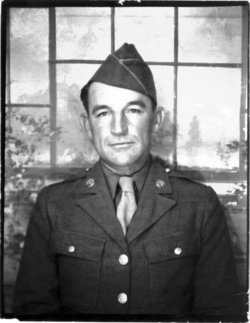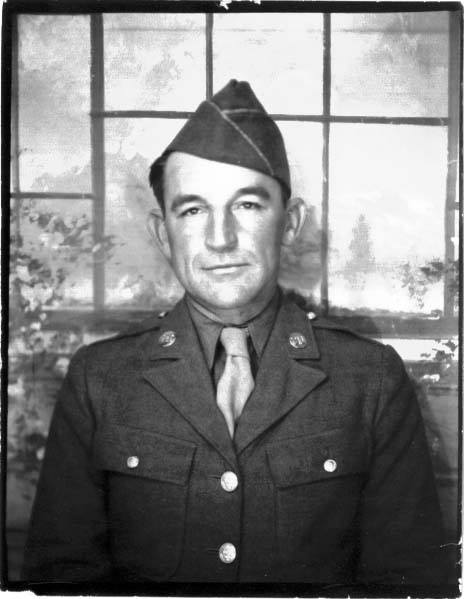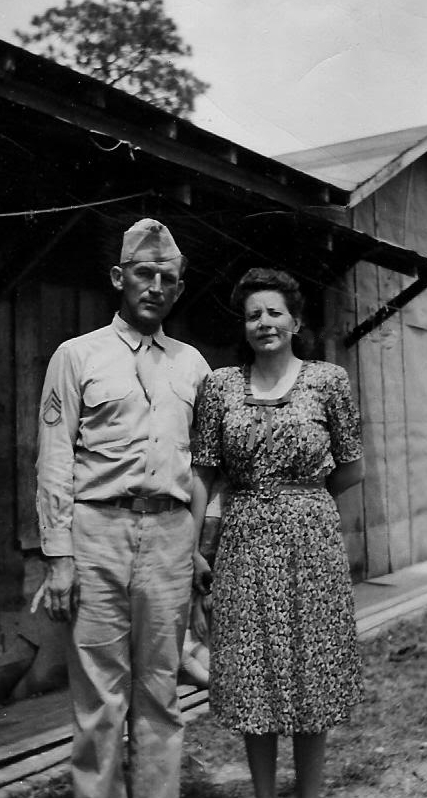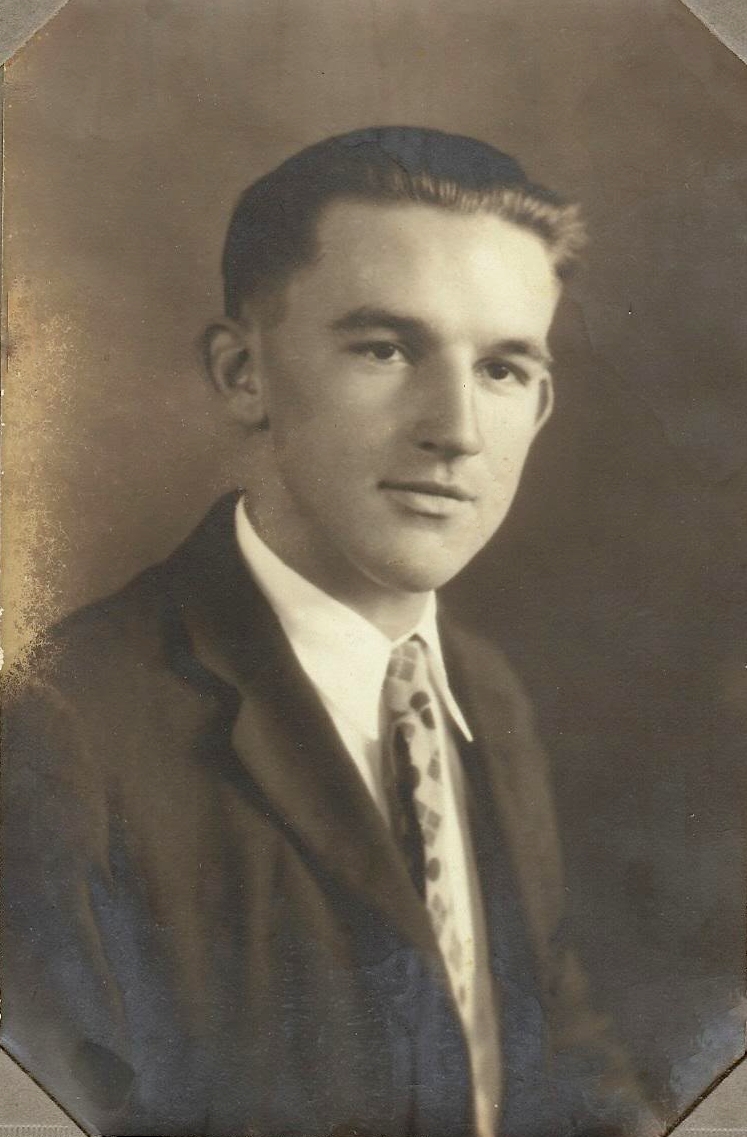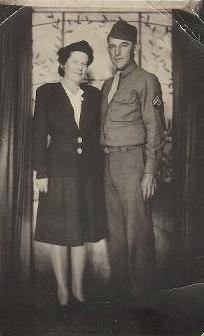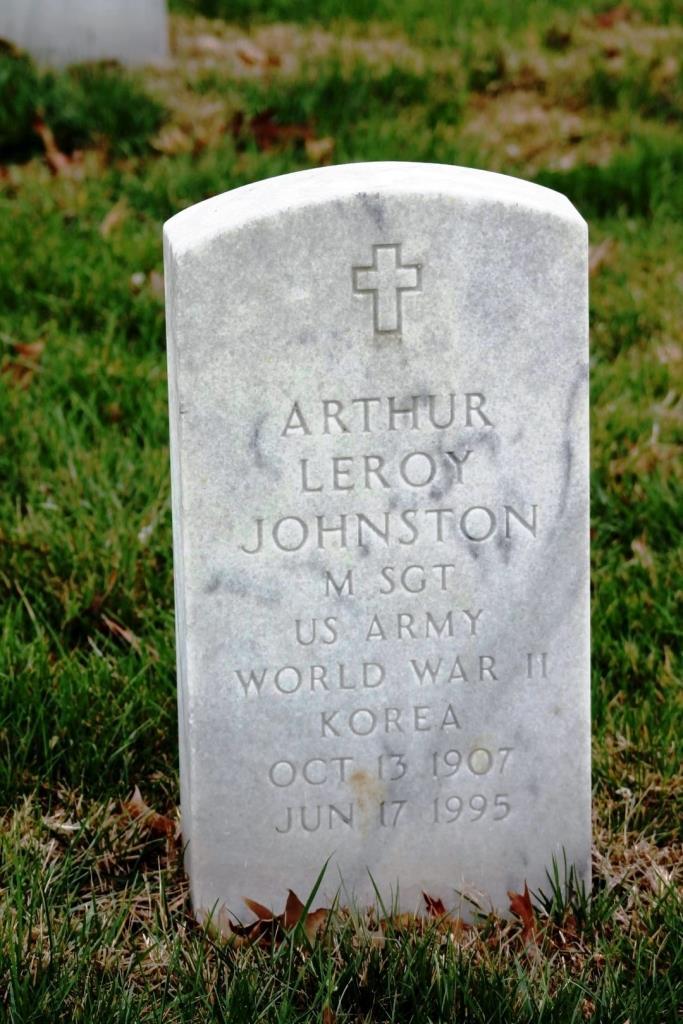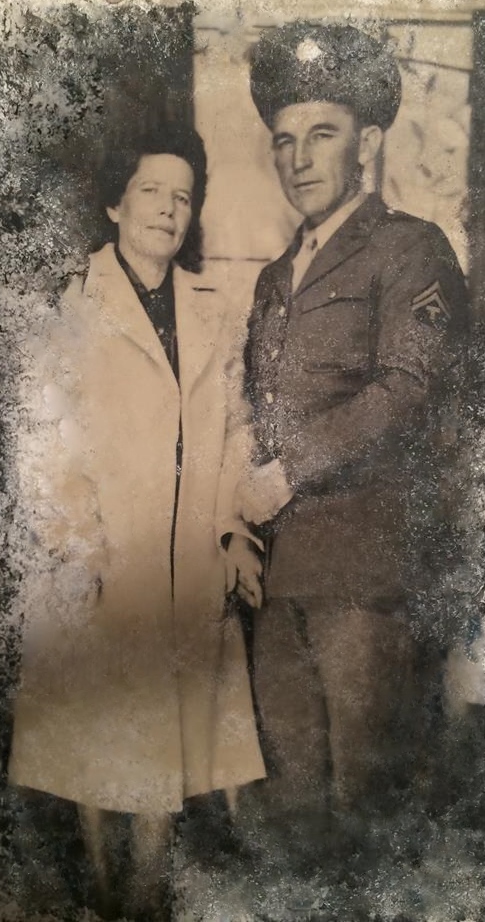MASTER SERGEANT, US ARMY,
WORLD WAR II, KOREA
Enlistment Date: 20 Oct 1943
Release Date: 31 Oct 1963
Birth Date: 13 Oct 1907
Death Date: 17 Jun 1995
Interment Date: 20 Jun 1995
"This is Arthur Johnston"
[his autobiography was written in 1978]:
"I was born in 1907, on the 13th of October near Stafford, Noble Co., Ohio." [NOTE: In 1851, Noble County was formed from parts of other southeastern Ohio counties, and some of the Monroe County population then lived across the county line in Noble County, but they still belonged to the community of Stafford. This site doesn't recognize Stafford as being part of Noble County.]
In 1910 we moved from Ohio to South Dakota along the Missouri River. Between there and the time we moved to Arizona was ten years.
I can remember catching some nice fish when we lived on the Missouri River -- one of them was a Catfish. When I had it hung over my shoulder on a string, it hung from my shoulder blade and his tail was dragging on the ground. I caught a couple of other longer fish. One of them was an eel and the other was a brown skin Stewart. I wasn't very tall at the time, however.
My first year of school was at Akaska, South Dakota; that is about 12 miles from Wesley Bowl, where we moved to later. Then we were living directly on the Missouri River, and we lived there about seven or eight years, after which we moved to Conde, SD, which is about 100 miles to the east. My brother, Landseer/Lanseer, worked for the American Railway Express Company. One of his jobs was there -- first from Naples along the Missouri River to the Conde, then later from Conde he had other routes but I don't remember all of them. Later on, during the depression years, he went down to Sioux City, Iowa. He worked out of there for many, many years, then went east from there to Chicago. I can remember being with him and the baggage cars on the trips it made, we had to crawl through that little place up there above the lights, in the middle of the car. Sometimes he had two extra box cars filled with cream cans.
I have one sister in Lyman who is about 13 years older than I. I also have two brothers; Lester was 2 years and 3 months older, and Lanseer was 10 years and 3 months older. I was the baby.
I can't remember teachers that far back; it's been a long long time.
One of the bad habits I accumulated early in life was smoking. First we started smoking grass and weeds; later on driftwood. Then finally we would go to the little store and get stuff at the store that mother would send us after; it was my brother, Lester, and I who would go. One of us would go buy whatever it was that we had some money for, and the other would go over to the showcase where they kept the Bull Durham tobacco. Very conveniently there was a broken glass there, and we'd back up there and reach in and lay our nickel down and pick up a sack of Bull Durham. That's how we got our smoking tobacco.
In 1920, two years after my mother died, we moved from Conde, South Dakota to 115 (now labeled 301 N, 259 ft. away) Picacho Street (corner N. 3rd St., near N. Florence St., "$30/month rental" on 1920 Census), Casa Grande, Arizona, where my widower father had a store. My father ran a so-called all-around store. In those days they didn't have any shopping centers, but that's what it was, in a small way. He handled everything from meat to groceries to hardware at Johnston's Grocery Store, listed on the National Register of Historic Places since 1985.
I used to swim a little bit. I was pretty good for the underwater swimming but not so good at the diving. I did do a little high diving, with not too good of results, I dove off a 24-foot board, and I cut too shallow. I wrenched my back and also mashed my nose against the bottom. I didn't go to the doctor for it. Because of wrenching my back, for three weeks I walked around like an ape with my arms hanging down, stooped over. Just about the time I was able to walk straight, they insisted I go to a chiropractor. O.K., he did what I guess he wanted to do. He did the same thing over to my back that happened in the first place. So for three more weeks I walked around with my arms hanging and stooped over again. As a result, I don't believe in Chiropractors.
As far as grades were concerned in the class, I wasn't the brightest kid, but I wasn't the dumbest either. I wasn't too good in English, but, otherwise, in mathematics and scientific matters I shined up pretty good. Also in History. My History teacher, Mr. Garff said, "Arthur, I'd like to flunk you, but I can't because you know too much history"! On the Scientific end, some of the girls would say to me, "Arthur, we don't have our lessons done; start an argument". So obligingly, whether or not I was on one side or another, anything to start an argument and keep it going, so I‘d bring up something. One time we
argued over how deep a ship would sink if the sea was deep enough. Would it keep on going to the bottom, or wouldn't it?. We kept arguing this thing for several days. Finally, the principal, Mr. Reason, got ahold of it, and he called me in on the carpet and said, "Hey, there will be no more of the arguing! I've got quite a record on you. You've done enough".
I was talented in History, Geometry, Mathematics, and I was pretty good with a camera also. The girls would pose for me most any ways, nothing bad, of course, but I would really show them off in their costumes they had on in plays, etc. In my Senior year of high school, I was the photographer of the school's yearbook. I had so many good pictures that I turned in, but I guess all the books are lost, because I haven't seen any for years. Apparently I got some very good pictures of all kinds except maybe one or two.
One kid, egged on by all the others, had three fights in one week to decide who was the best, but I guess it was a draw, because we became good friends after that. The high school I went to was Casa Grande Union High School in Arizona.
I quit school in my senior year to get married. I often regretted that.
[Art & Myrt were both 21 when they got married (?) On 1930 Census - $15/month rent - Art (Iceman/Ice) & Myrtle (both 23) & baby Lee Roy (1 yr, 3 mos) were living with his dad, "G.W." when Johnston's Grocery Store, Casa Grande, AZ was also a residence.]
Later on I got an equivalent to a high school diploma in the Army. Later I was working on one year of college, but I went on assignment and was unable to take the final examination, so I haven't received credit for that yet.
I have been very healthy most of my life. I haven't had any problems.
On Sports: I didn't have too much time for those, because my father wanted me to help at the store. It was about ½ mile from the high school. At noon I would double time down to the store and help him out and grab a little bite to eat and then double time back to school. After school I'd do it again, so I didn't have too much time for sports. When I was going to school and after, I used to average four books a week. I had two library cards to use.
I can remember my first ride was on an old model T. That was about my first experience with an automobile.
When I was about 14 I was working all day, and at night I drove a Ford ton truck 66 miles over no roads at all, between Casa Grande and Tucson, Arizona. It would take all night to get there and I'd sleep all day while the boss was selling produce. When he got rid of it, whether it was that day or when, we'd take off and drive 66 miles back. The other days I'd be counting eggs and buying poultry, getting ready for another trip. That was my first job.
I was always busy in whatever there was to do. In those days kids didn't expect anything; we had to earn it. My brother and I would chop and saw wood, one on each end of the saw. Sometimes we would trap muskrats and rabbits which usually went into the pot, because I took the hides and put them on a stretcher, and then, periodically, sold what hides we had.
I had a dog and I was trying to figure a name for him; I read the Karo syrup signs, and I mispronounced it a little bit, so I called the dog "Kyro" instead of Karo. We had several dogs. Once we had a dog that was greyhound; it was half bulldog and greyhound. He was really a scrapper. We got a greyhound purebred and had him a short time and our other dog ended up dead.
My father, George Washington Johnston, lived until he was 64 years old. My mother, Nevada Day Johnston, died with the flu in 1918. My grandfather on my father's side was Solomon Johnston. My grandmother was Sarah Johnson Johnston; she was kind of a mean one, I think, according to my dad. She spent ten years in bed to spite her old man, and when she was 85 years old, she got out of bed and drove several miles to see her first railroad train. On my mother's side, her father, George Day, was a farmer and raised lots of peaches and watermelons. One time a bunch of cousins and I got in the watermelon patch and ate all of the watermelons. My mother's mother was Lydia Day.
On July 10, 1935, my father, George W. Johnston, died from injuries sustained in a robbery encounter the day before. The robbers took the loaded pistol he had away from him. He always kept it under his pillow, I can remember, ever since I was a small boy. They also had a lead pipe, and, some way or other, they used both the pipe and gun and pistol-whipped him, and he was so badly hurt that he died the next evening. The two boys who had done the job were so-called American/Mexicans. They were caught, along with the $13.00 and the pistol -- that was the amount taken in the robbery. My father's pistol had been kept in the part of the store that was also used as a residence. These two boys were tried and convicted with 20 years to life for one, and the other had the death sentence, which was carried out in the gas chamber in Florence, Arizona. Approximately a year or two from the time of the robbery, they called up and wanted my brother and I to come over for witnesses to the execution, but we told them we'd be madder than heck if they didn't carry it out, but that we felt that we wanted no part of seeing such an item. The boy that had 20 years to life died in prison a couple of years later, apparently of some disease or natural causes as far as I know.
If we wrote down all the jobs I had, it would take us a day and a half, and I don't think we've got that much time. I worked for the Arizona Ice and Cold Storage at Casa Grande, Arizona for nine years, then I decided I didn't like it and quit. [March 5, 1937 - "Arthur Johnston will take over Ray Kastner's position with the Arizona Ice and Cold Storage Company. Mr. Kastner, who has been in Casa Grande with the ice company for the past eight years left last week for Phoenix to take a position with the Constable Ice Company to operate one of their routes."] Then we moved up to Northern Arizona where I drew my first unemployment -- that was the first year they had unemployment. I also learned how to be a woodsman during that period, chopping down and peeling post.
[Employed: 1-20-42 to 7-20-42 for Atchison, Topeka & Santa Fe-Coastline - as Track Section Laborer, AZ Division - Promoted 7-20-42 to 10-10-42 as Student Section Foreman, Needles Yard, AZ Div (then Student Foreman disapproved - returned to Track Laborer). 5' 10-1/2", 163 lbs, brown eyes, dark hair.]
Later on, four of the Pointer brothers and I took a contract for building a lot of fence, and I gradually worked in to a demolition end of it. I got lots of experience which I carried right on into the Army, being a Specialist on Excovery, (?) and sometimes I had as many as 460 people working for me. Another time I was assigned the maintenance in the headquarters building of I.D.(?) Department, they called it, in Frankfort, Germany, at which time I had as high as 650 people working for me.
I had five boys; Lee Roy was born the day after Christmas in 1928, and the others scattered out over 2 or 3 or 4 to 5 years apart. One of them was named Robert -- he was the second oldest -- we call him "Bob". William was the middle -- they called him "Pete," but I still call him "Billy". Then there was Jerry and Troy, who was born over in a little Mormon town called "Short Creek" in 1940. I got a divorce in 1951.
I met my present wife, Ann in Germany in about 1951, and we were married in 1955, both by the German government and the American. That was on 28th and 29th of January in 1955. Shortly after I met Ann, she couldn't speak English, except for a few words which they said that they had learned from their teacher, who was a priest. I met him later, and he taught them English. I tried to talk to the teacher in English, but we couldn't make it score, because he didn't talk enough of it to do any good. She had trouble pronouncing words, and she'd try to say mule and she'd say "mool", so I said, "When I get out of the Army, we're going to St. Louis, Missouri, and I'm going to buy forty acres and a "mool", never thinking that we really would move to Missouri.
When I served before I was out of the Army, I was transferred to an Army post in Missouri, and I didn't like that, so I stopped in St. Louis. I was on absent leave time, and I found a job there, but I had to get it approved, so I had to go to the State Capitol at Judson, Missouri to get an O.K. They liked me alright, and they wanted me; they asked me if I couldn't go to Chicago to be sure there would be no hitch on the taxpayers and one thing or another. I did, and when I got into the Army Headquarters, I ran into an old Army buddy there from Europe, and he said, "Anywhere you want to go, you've got it." So I told him where I wanted to go; he made up the papers, and I didn't even have to see an officer. I was assigned to this job as an Advisor to the National Guard at Jefferson Bay, St. Louis, Missouri -- an old Army Post. On that job I was there for... (they call it different now), but I had been with the Orients before, and I didn't like their way of living, because they didn't have any values at all, so I put in for retirement. A year later, I was retired after a little better than 20 years in the regular Army and four years or better in the National Guard, making a total of very close to 25 years of service all together.
My present wife, Ann, and I returned to St. Louis; we never did buy a farm. We bought a small place though, after about a year. It had a house on the property; it was old-fashioned, so we completely re-did it. In fact, we tore the windows out and tore everything from the inside and threw them out through the windows and rebuilt from scratch and added a room 17x24 as a living room/dining room combination. We did all the work ourselves, except my father-in-law, who was 73 years old at the time, laid the brick and the cement blocks for the wall.
Ann's parents were very nice people. Her father's name was Yohann Snipper; they were from east of Cologne about 23 miles and right off the Rindland of Germany. Ann's mother's name was Maria, and she was a little short person with, oh, such a pleasant disposition.
In 1969, my sister, Lina Elma J. Miracle died of cancer; in 1962 one of my brothers, Lester Lawrence, when he was approximately 57 years old, had a heart attack while on his job as a night watchman in Sioux City, Iowa. My oldest brother died last Fall, which would make it 1977, and we buried him two days later on Oct. 13th -- which is, incidentally, my 70th birthday.
As far as being related to some Civil War or other General Johnston, I have no knowledge of that ever happening, although I do know -- and I've looked into the history books and encyclopedias so many times and found so many General Johnston's this, and so many General Johnston's that, but I know of no connection between them and myself or any of our relatives.
Our family was always a very honest family. Once one of my own sons accused me of being too honest. I told him, "No man can ever be too HONEST."
I did take dance lessons at one time and was told I was a good dancer. I also took an exercise class for awhile. Ann and I used to dance quite a bit until my hearing became obstructed in my later years.
Art (20) & Myrt (22) were said to be attending Casa Grande Union High School on February 24, 1928, when Art quit during his Senior year to marry Myrt in Casa Grande and regretted that decision later on, although he got his GED in the Army. He took many of the photographs for the 1928 yearbook.
The original Casa Grande Union High School in Casa Grande, Pinal County, Arizona was built in 1920-21. It featured an indoor swimming pool and an auditorium. The large building's construction was a major milestone for the growing town between Phoenix and Tucson. The original high school and gym, now used as the Casa Grande City Hall since 1997, when the new high school was completed at a new location, are listed on the National Register of Historic Places, as is "Johnson's" (Johnston's) Grocery.
MASTER SERGEANT, US ARMY,
WORLD WAR II, KOREA
Enlistment Date: 20 Oct 1943
Release Date: 31 Oct 1963
Birth Date: 13 Oct 1907
Death Date: 17 Jun 1995
Interment Date: 20 Jun 1995
"This is Arthur Johnston"
[his autobiography was written in 1978]:
"I was born in 1907, on the 13th of October near Stafford, Noble Co., Ohio." [NOTE: In 1851, Noble County was formed from parts of other southeastern Ohio counties, and some of the Monroe County population then lived across the county line in Noble County, but they still belonged to the community of Stafford. This site doesn't recognize Stafford as being part of Noble County.]
In 1910 we moved from Ohio to South Dakota along the Missouri River. Between there and the time we moved to Arizona was ten years.
I can remember catching some nice fish when we lived on the Missouri River -- one of them was a Catfish. When I had it hung over my shoulder on a string, it hung from my shoulder blade and his tail was dragging on the ground. I caught a couple of other longer fish. One of them was an eel and the other was a brown skin Stewart. I wasn't very tall at the time, however.
My first year of school was at Akaska, South Dakota; that is about 12 miles from Wesley Bowl, where we moved to later. Then we were living directly on the Missouri River, and we lived there about seven or eight years, after which we moved to Conde, SD, which is about 100 miles to the east. My brother, Landseer/Lanseer, worked for the American Railway Express Company. One of his jobs was there -- first from Naples along the Missouri River to the Conde, then later from Conde he had other routes but I don't remember all of them. Later on, during the depression years, he went down to Sioux City, Iowa. He worked out of there for many, many years, then went east from there to Chicago. I can remember being with him and the baggage cars on the trips it made, we had to crawl through that little place up there above the lights, in the middle of the car. Sometimes he had two extra box cars filled with cream cans.
I have one sister in Lyman who is about 13 years older than I. I also have two brothers; Lester was 2 years and 3 months older, and Lanseer was 10 years and 3 months older. I was the baby.
I can't remember teachers that far back; it's been a long long time.
One of the bad habits I accumulated early in life was smoking. First we started smoking grass and weeds; later on driftwood. Then finally we would go to the little store and get stuff at the store that mother would send us after; it was my brother, Lester, and I who would go. One of us would go buy whatever it was that we had some money for, and the other would go over to the showcase where they kept the Bull Durham tobacco. Very conveniently there was a broken glass there, and we'd back up there and reach in and lay our nickel down and pick up a sack of Bull Durham. That's how we got our smoking tobacco.
In 1920, two years after my mother died, we moved from Conde, South Dakota to 115 (now labeled 301 N, 259 ft. away) Picacho Street (corner N. 3rd St., near N. Florence St., "$30/month rental" on 1920 Census), Casa Grande, Arizona, where my widower father had a store. My father ran a so-called all-around store. In those days they didn't have any shopping centers, but that's what it was, in a small way. He handled everything from meat to groceries to hardware at Johnston's Grocery Store, listed on the National Register of Historic Places since 1985.
I used to swim a little bit. I was pretty good for the underwater swimming but not so good at the diving. I did do a little high diving, with not too good of results, I dove off a 24-foot board, and I cut too shallow. I wrenched my back and also mashed my nose against the bottom. I didn't go to the doctor for it. Because of wrenching my back, for three weeks I walked around like an ape with my arms hanging down, stooped over. Just about the time I was able to walk straight, they insisted I go to a chiropractor. O.K., he did what I guess he wanted to do. He did the same thing over to my back that happened in the first place. So for three more weeks I walked around with my arms hanging and stooped over again. As a result, I don't believe in Chiropractors.
As far as grades were concerned in the class, I wasn't the brightest kid, but I wasn't the dumbest either. I wasn't too good in English, but, otherwise, in mathematics and scientific matters I shined up pretty good. Also in History. My History teacher, Mr. Garff said, "Arthur, I'd like to flunk you, but I can't because you know too much history"! On the Scientific end, some of the girls would say to me, "Arthur, we don't have our lessons done; start an argument". So obligingly, whether or not I was on one side or another, anything to start an argument and keep it going, so I‘d bring up something. One time we
argued over how deep a ship would sink if the sea was deep enough. Would it keep on going to the bottom, or wouldn't it?. We kept arguing this thing for several days. Finally, the principal, Mr. Reason, got ahold of it, and he called me in on the carpet and said, "Hey, there will be no more of the arguing! I've got quite a record on you. You've done enough".
I was talented in History, Geometry, Mathematics, and I was pretty good with a camera also. The girls would pose for me most any ways, nothing bad, of course, but I would really show them off in their costumes they had on in plays, etc. In my Senior year of high school, I was the photographer of the school's yearbook. I had so many good pictures that I turned in, but I guess all the books are lost, because I haven't seen any for years. Apparently I got some very good pictures of all kinds except maybe one or two.
One kid, egged on by all the others, had three fights in one week to decide who was the best, but I guess it was a draw, because we became good friends after that. The high school I went to was Casa Grande Union High School in Arizona.
I quit school in my senior year to get married. I often regretted that.
[Art & Myrt were both 21 when they got married (?) On 1930 Census - $15/month rent - Art (Iceman/Ice) & Myrtle (both 23) & baby Lee Roy (1 yr, 3 mos) were living with his dad, "G.W." when Johnston's Grocery Store, Casa Grande, AZ was also a residence.]
Later on I got an equivalent to a high school diploma in the Army. Later I was working on one year of college, but I went on assignment and was unable to take the final examination, so I haven't received credit for that yet.
I have been very healthy most of my life. I haven't had any problems.
On Sports: I didn't have too much time for those, because my father wanted me to help at the store. It was about ½ mile from the high school. At noon I would double time down to the store and help him out and grab a little bite to eat and then double time back to school. After school I'd do it again, so I didn't have too much time for sports. When I was going to school and after, I used to average four books a week. I had two library cards to use.
I can remember my first ride was on an old model T. That was about my first experience with an automobile.
When I was about 14 I was working all day, and at night I drove a Ford ton truck 66 miles over no roads at all, between Casa Grande and Tucson, Arizona. It would take all night to get there and I'd sleep all day while the boss was selling produce. When he got rid of it, whether it was that day or when, we'd take off and drive 66 miles back. The other days I'd be counting eggs and buying poultry, getting ready for another trip. That was my first job.
I was always busy in whatever there was to do. In those days kids didn't expect anything; we had to earn it. My brother and I would chop and saw wood, one on each end of the saw. Sometimes we would trap muskrats and rabbits which usually went into the pot, because I took the hides and put them on a stretcher, and then, periodically, sold what hides we had.
I had a dog and I was trying to figure a name for him; I read the Karo syrup signs, and I mispronounced it a little bit, so I called the dog "Kyro" instead of Karo. We had several dogs. Once we had a dog that was greyhound; it was half bulldog and greyhound. He was really a scrapper. We got a greyhound purebred and had him a short time and our other dog ended up dead.
My father, George Washington Johnston, lived until he was 64 years old. My mother, Nevada Day Johnston, died with the flu in 1918. My grandfather on my father's side was Solomon Johnston. My grandmother was Sarah Johnson Johnston; she was kind of a mean one, I think, according to my dad. She spent ten years in bed to spite her old man, and when she was 85 years old, she got out of bed and drove several miles to see her first railroad train. On my mother's side, her father, George Day, was a farmer and raised lots of peaches and watermelons. One time a bunch of cousins and I got in the watermelon patch and ate all of the watermelons. My mother's mother was Lydia Day.
On July 10, 1935, my father, George W. Johnston, died from injuries sustained in a robbery encounter the day before. The robbers took the loaded pistol he had away from him. He always kept it under his pillow, I can remember, ever since I was a small boy. They also had a lead pipe, and, some way or other, they used both the pipe and gun and pistol-whipped him, and he was so badly hurt that he died the next evening. The two boys who had done the job were so-called American/Mexicans. They were caught, along with the $13.00 and the pistol -- that was the amount taken in the robbery. My father's pistol had been kept in the part of the store that was also used as a residence. These two boys were tried and convicted with 20 years to life for one, and the other had the death sentence, which was carried out in the gas chamber in Florence, Arizona. Approximately a year or two from the time of the robbery, they called up and wanted my brother and I to come over for witnesses to the execution, but we told them we'd be madder than heck if they didn't carry it out, but that we felt that we wanted no part of seeing such an item. The boy that had 20 years to life died in prison a couple of years later, apparently of some disease or natural causes as far as I know.
If we wrote down all the jobs I had, it would take us a day and a half, and I don't think we've got that much time. I worked for the Arizona Ice and Cold Storage at Casa Grande, Arizona for nine years, then I decided I didn't like it and quit. [March 5, 1937 - "Arthur Johnston will take over Ray Kastner's position with the Arizona Ice and Cold Storage Company. Mr. Kastner, who has been in Casa Grande with the ice company for the past eight years left last week for Phoenix to take a position with the Constable Ice Company to operate one of their routes."] Then we moved up to Northern Arizona where I drew my first unemployment -- that was the first year they had unemployment. I also learned how to be a woodsman during that period, chopping down and peeling post.
[Employed: 1-20-42 to 7-20-42 for Atchison, Topeka & Santa Fe-Coastline - as Track Section Laborer, AZ Division - Promoted 7-20-42 to 10-10-42 as Student Section Foreman, Needles Yard, AZ Div (then Student Foreman disapproved - returned to Track Laborer). 5' 10-1/2", 163 lbs, brown eyes, dark hair.]
Later on, four of the Pointer brothers and I took a contract for building a lot of fence, and I gradually worked in to a demolition end of it. I got lots of experience which I carried right on into the Army, being a Specialist on Excovery, (?) and sometimes I had as many as 460 people working for me. Another time I was assigned the maintenance in the headquarters building of I.D.(?) Department, they called it, in Frankfort, Germany, at which time I had as high as 650 people working for me.
I had five boys; Lee Roy was born the day after Christmas in 1928, and the others scattered out over 2 or 3 or 4 to 5 years apart. One of them was named Robert -- he was the second oldest -- we call him "Bob". William was the middle -- they called him "Pete," but I still call him "Billy". Then there was Jerry and Troy, who was born over in a little Mormon town called "Short Creek" in 1940. I got a divorce in 1951.
I met my present wife, Ann in Germany in about 1951, and we were married in 1955, both by the German government and the American. That was on 28th and 29th of January in 1955. Shortly after I met Ann, she couldn't speak English, except for a few words which they said that they had learned from their teacher, who was a priest. I met him later, and he taught them English. I tried to talk to the teacher in English, but we couldn't make it score, because he didn't talk enough of it to do any good. She had trouble pronouncing words, and she'd try to say mule and she'd say "mool", so I said, "When I get out of the Army, we're going to St. Louis, Missouri, and I'm going to buy forty acres and a "mool", never thinking that we really would move to Missouri.
When I served before I was out of the Army, I was transferred to an Army post in Missouri, and I didn't like that, so I stopped in St. Louis. I was on absent leave time, and I found a job there, but I had to get it approved, so I had to go to the State Capitol at Judson, Missouri to get an O.K. They liked me alright, and they wanted me; they asked me if I couldn't go to Chicago to be sure there would be no hitch on the taxpayers and one thing or another. I did, and when I got into the Army Headquarters, I ran into an old Army buddy there from Europe, and he said, "Anywhere you want to go, you've got it." So I told him where I wanted to go; he made up the papers, and I didn't even have to see an officer. I was assigned to this job as an Advisor to the National Guard at Jefferson Bay, St. Louis, Missouri -- an old Army Post. On that job I was there for... (they call it different now), but I had been with the Orients before, and I didn't like their way of living, because they didn't have any values at all, so I put in for retirement. A year later, I was retired after a little better than 20 years in the regular Army and four years or better in the National Guard, making a total of very close to 25 years of service all together.
My present wife, Ann, and I returned to St. Louis; we never did buy a farm. We bought a small place though, after about a year. It had a house on the property; it was old-fashioned, so we completely re-did it. In fact, we tore the windows out and tore everything from the inside and threw them out through the windows and rebuilt from scratch and added a room 17x24 as a living room/dining room combination. We did all the work ourselves, except my father-in-law, who was 73 years old at the time, laid the brick and the cement blocks for the wall.
Ann's parents were very nice people. Her father's name was Yohann Snipper; they were from east of Cologne about 23 miles and right off the Rindland of Germany. Ann's mother's name was Maria, and she was a little short person with, oh, such a pleasant disposition.
In 1969, my sister, Lina Elma J. Miracle died of cancer; in 1962 one of my brothers, Lester Lawrence, when he was approximately 57 years old, had a heart attack while on his job as a night watchman in Sioux City, Iowa. My oldest brother died last Fall, which would make it 1977, and we buried him two days later on Oct. 13th -- which is, incidentally, my 70th birthday.
As far as being related to some Civil War or other General Johnston, I have no knowledge of that ever happening, although I do know -- and I've looked into the history books and encyclopedias so many times and found so many General Johnston's this, and so many General Johnston's that, but I know of no connection between them and myself or any of our relatives.
Our family was always a very honest family. Once one of my own sons accused me of being too honest. I told him, "No man can ever be too HONEST."
I did take dance lessons at one time and was told I was a good dancer. I also took an exercise class for awhile. Ann and I used to dance quite a bit until my hearing became obstructed in my later years.
Art (20) & Myrt (22) were said to be attending Casa Grande Union High School on February 24, 1928, when Art quit during his Senior year to marry Myrt in Casa Grande and regretted that decision later on, although he got his GED in the Army. He took many of the photographs for the 1928 yearbook.
The original Casa Grande Union High School in Casa Grande, Pinal County, Arizona was built in 1920-21. It featured an indoor swimming pool and an auditorium. The large building's construction was a major milestone for the growing town between Phoenix and Tucson. The original high school and gym, now used as the Casa Grande City Hall since 1997, when the new high school was completed at a new location, are listed on the National Register of Historic Places, as is "Johnson's" (Johnston's) Grocery.
Inscription
US ARMY M SGT WORLD WAR II, KOREA
Family Members
Sponsored by Ancestry
Advertisement
Records on Ancestry
Advertisement
